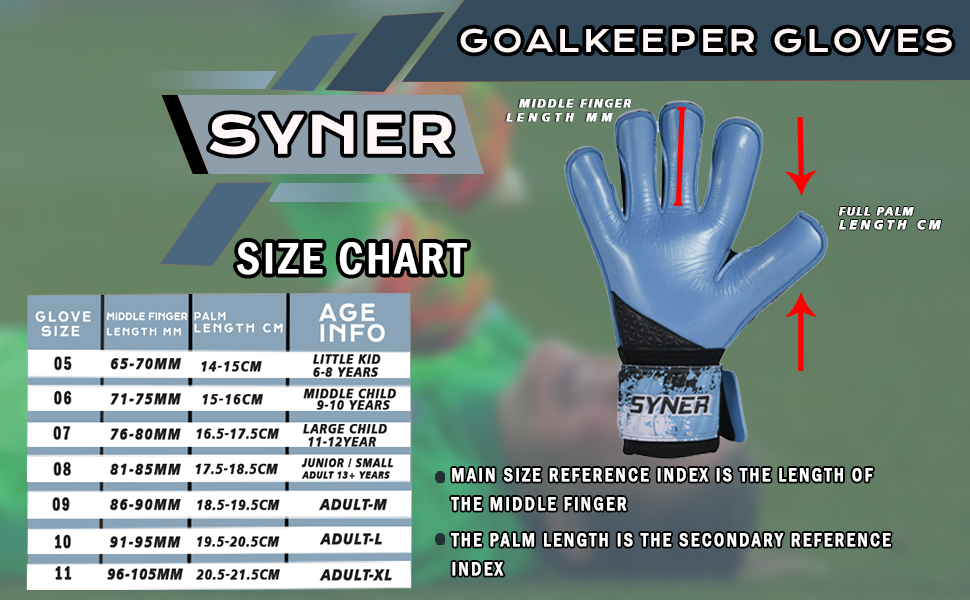Glove care is key to ensure the longevity and maximise the grip from the gloves you buy.
Caring for your Goalkeeping Gloves
1. Before using your gloves for the first time you must ensure you give the gloves a pre wash. Wash the gloves in lukewarm water with no detergent, this will maximise the grip and durability of the gloves and make sure there ready for your next session. Once you’ve washed the gloves make sure you allow them to dry naturally out of direct sunlight.
2. Whilst using your gloves in dry conditions you must ensure the palms are kept damp again this will increase the grip and longevity of the gloves. If you are playing in wet weather it’s a good idea to have a towel to dry the gloves to keep them in there optimum condition.
3. After your session or match it’s crucial you wash the gloves throughly. This can be done with plain lukewarm water or you can add a specialised goalkeeper glove wash which will help get the gloves back in tip top condition. Hand washing is the only way to wash your gloves, if you decide to put them in the washing machine this will only deteriorate the latex at an massively increased rate.
4. Once you’ve washed the gloves make sure you allow them to dry naturally out of direct sunlight. Do not force dry your gloves with anything… latex being a natural product this will only cause a rapid deterioration in the latex.
• Don’t hairdryer
• Don’t put them on a radiator
• Don’t tumble dry
• Don’t put them in airing cupboard
Basically just allow the gloves to dry naturally in a cool dark place. Let the gloves dry for 12 hours naturally before storing.
5. Once the gloves have dried it is crucial you store the gloves in either the bag they came in or in a dedicated glove bag. This will ensure the gloves are kept moist which will prolong the lifespan of the gloves. With latex being a natural product if left out dry the latex will become brittle and will be next to useless.
6. It is key to not store wet gloves at any time it is very important to make sure you don’t store away damp or sweaty gloves. This damp and sweet can cause bacteria to form on the lining of the gloves which will deteriorate the lining of the gloves very quickly and render them next to useless.
Latex Deterioration
At Syner Sports we only use the highest quality latex available in the manufacture of our goalkeeper gloves. Latex is a natural product so it needs a lot of care, with the latex being In a working environment subject to wear and tear over many matches and sessions Syner Sports cannot be held accountable for the natural wear and tear of the latex palm. All latex’s will show signs of wear and tear but the latex will still grip till there is almost no latex left on the palm. We at Syner Sports use 4mm latex foam so there is plenty of latex on the palm to further insure the longevity of the gloves we sell.
FLAT PALM
The Flat Palm cut is a classic and still popular cut to this day, and one of the originals to emerge once the goalkeeper glove market began to develop. On a flat palm cut you will see that its stitched gussets are located on the outside this gives a looser feel. The cut also consists of one single piece of latex attached to the back of the glove, with the gussets in between the fingers and palm.
HYBRID CUT
Our Hybrid Cut is a Hybrid Cut that combines negative and roll fingers to create another unique feel and style. The middle two fingers are negative while the outside fingers are rolled. This was developed to create a snug and true feel for your middle fingers as they wrap around the ball where as the outside roll fingers provide that additional latex-to-ball contact improving grip in core ball-to-glove touch points. A good example of our Hybrid Cut can be seen on our AquaHy model.
ROLL FINGER
Roll-finger goalkeeper gloves are one of the most popular and traditional cuts currently available. They are named “roll fingers” due to the fact that the backhand is connected to the palm and does not use gussets. The result is the latex rolled/curved around the fingers which provides great latex contact with the ball but is not as snug or tight as a feel in comparison to negative cut gloves, or hybrids that use negative. While it does provide a comfortable feel, some may view it as a slightly larger or “bulkier” cut vs negative type gloves.
NEGATIVE CUT
Negative-cut goalkeeper gloves have become increasingly popular over the past years, particularly across Europe. They are similar to the flat cut in that they use a single piece of latex attached to the backhand via gussets, the key difference is that the stitching/gussets are inside the glove. This provides a much tighter and snug fit with control on the ball that is more “true” to your hand. Due to this, gloves utilizing this type of cut will wear slightly quicker than roll fingers for example.
NEGATIVE ROLL
The Negative Roll cut is a hybrid style that combines negative and roll fingers to produce an even greater level of comfort, fit, and feel. The fingers are rolled in the same way any roll-finger glove will, but the inside of the palm is stitched much like a negative glove. The benefits of this combination mean that if a snug fit is your thing and you are a fan of negative gloves, you can have an even better fit but with more latex contact on the ball thanks to the rolled fingers. For those used to a more open or loose-fitting glove, you may want to consider going one size up when choosing a glove with this cut.
GOALKEEPER GLOVE GRIP GUIDE
There are many types of latex available on the goalkeeper glove market and it can be confusing to know the benefits and attributes of each type. How durable is it? What is the grip like? How does it perform in the wet? We are here to answer all your questions with our simple guide below.
It is important to note that these ratings are best on the gloves being looked after with our best practice Glove Care guide. Latex is a natural material that will be subject to abrasion from the very first use, and as such, the durability, in particular, may vary depending on how well this is followed and the type of surface you play on.
Contact
Dry Weather: 10/10
Wet Weather: 9/10
Durability: 8/10
Contact is a latex that delivers pro-grade grip in dry conditions while still performing very well in the wet providing you look after and towel excess water (as you should with any glove). It is the go-to match-day latex for many of our professionals and is used across every tier of English football.
Aqua Latex (Wet Weather)
Dry Weather: 7/10
Wet Weather: 10/10
Durability: 8/10
Aqua is a Latex that delivers unrivaled grip in extreme wet weather conditions, without the need for excess drying with a towel. It is crucial you keep the latex wet/damp during use in dry conditions to avoid excess latex deterioration. It a great latex and always a good idea to have a pair of aqua gloves in your bag just in case the heavens open.
QUARTZ LATEX
Dry Weather: 9/10
Wet Weather: 7/10
Durability: 10/10
Quartz latex is a great “all-rounder” that would be well placed as an in-between of Giga and Contact. It demonstrates very good grip in the dry, good in wet conditions, and also shows solid durability.
Mega Grip
Dry Weather: 7/10
Wet Weather: 6/10
Durability: 6/10
Supersoft
Dry Weather: 6/10
Wet Weather: 6/10
Durability: 4/10
Giga Grip
Dry Weather: 7/10
Wet Weather: 7/10
Durability: 7/10
Best way to determine goalie glove sizing is to measure the length of the goalkeeper's hand from tip of the middle finger to the end of the palm. General rule is to round up and add a size. Hand measurement of 7 inches would be a size 8.


